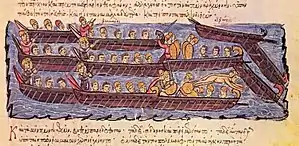941
Year 941 (CMXLI) was a common year starting on Friday (link will display the full calendar) of the Julian calendar.
| Millennium: | 1st millennium |
|---|---|
| Centuries: | |
| Decades: | |
| Years: |
| 941 by topic |
|---|
| Leaders |
|
| Categories |
|
| Gregorian calendar | 941 CMXLI |
| Ab urbe condita | 1694 |
| Armenian calendar | 390 ԹՎ ՅՂ |
| Assyrian calendar | 5691 |
| Balinese saka calendar | 862–863 |
| Bengali calendar | 348 |
| Berber calendar | 1891 |
| Buddhist calendar | 1485 |
| Burmese calendar | 303 |
| Byzantine calendar | 6449–6450 |
| Chinese calendar | 庚子年 (Metal Rat) 3637 or 3577 — to — 辛丑年 (Metal Ox) 3638 or 3578 |
| Coptic calendar | 657–658 |
| Discordian calendar | 2107 |
| Ethiopian calendar | 933–934 |
| Hebrew calendar | 4701–4702 |
| Hindu calendars | |
| - Vikram Samvat | 997–998 |
| - Shaka Samvat | 862–863 |
| - Kali Yuga | 4041–4042 |
| Holocene calendar | 10941 |
| Iranian calendar | 319–320 |
| Islamic calendar | 329–330 |
| Japanese calendar | Tengyō 4 (天慶4年) |
| Javanese calendar | 841–842 |
| Julian calendar | 941 CMXLI |
| Korean calendar | 3274 |
| Minguo calendar | 971 before ROC 民前971年 |
| Nanakshahi calendar | −527 |
| Seleucid era | 1252/1253 AG |
| Thai solar calendar | 1483–1484 |
| Tibetan calendar | 阳金鼠年 (male Iron-Rat) 1067 or 686 or −86 — to — 阴金牛年 (female Iron-Ox) 1068 or 687 or −85 |

Events
Byzantine Empire
- May – September – Rus'–Byzantine War: The Rus' and their allies, the Pechenegs, under the Varangian prince Igor I of Kiev, cross the Black Sea with an invasion fleet of 1,000 ships[1] (40,000 men) and disembark on the northern coast of Asia Minor. While the Byzantine fleet is engaged against the Arabs in the Mediterranean, the Rus' forces reach the gates of Constantinople. Emperor Romanos I organizes the defense of the capital and assembles 15 old ships (equipped with throwers of Greek fire) under the chamberlain (protovestiarios) Theophanes. The Byzantines repel the Rus' fleet (nearly annihilating the entire fleet) but can not prevent the invaders from pillaging the hinterland of Constantinople, venturing as far south as Nicomedia (modern-day İzmit). In September, John Kourkouas and Bardas Phokas ("the Elder"), two leading generals, destroy the Rus' forces in Thrace. Igor manages, with only a handful of boats, to escape to the Caspian Sea.
Europe
- Spring – Henry I, duke of Bavaria, plots to assassinate his brother, King Otto I, at the royal palace in Quedlinburg (modern Saxony-Anhalt), but the conspiracy is discovered and Henry is put in captivity in Ingelheim. He is released after doing penance at Christmas.
- Fall – Hugh of Provence, king of Italy, leads a fourth expedition to Rome to dislodge Alberic II. He proceeds to Lazio, preparing a campaign to capture the papal capital. Again the attacks fail and Hugh retreats to Milan.
- Olaf Guthfrithson, a Norse-Irish chieftain, is killed while raiding an ancient Anglian church at Tyninghame (Northern Northumbria). He is succeeded by his cousin Olaf Sigtryggsson as ruler of Jórvik (modern Yorkshire).
Middle East
Births
Deaths
- January 5 – Zhang Yanhan, Chinese chancellor (b. 884)
- February 12 – Wulfhelm, archbishop of Canterbury
- April 21 – Bajkam, Turkish military commander
- Abu Bakr Muhammad, Muslim governor
- Fujiwara no Sumitomo, Japanese nobleman
- Gurgen II, prince of Tao-Klarjeti (Georgia)
- Jayavarman IV, Angkorian king (Cambodia)
- Muhammad ibn Ya'qub al-Kulayni, Persian scholar (b. 864)
- Olaf Guthfrithson, Viking leader and king[2]
- Órlaith íngen Cennétig, Irish queen
- Qian Yuanguan, king of Wuyue (b. 887)
- Rudaki ("Adam of Poets"), Persian poet (b. 858)
- Wang Dingbao, Chinese chancellor (b. 870)
- Zhao Sun, Chinese official and chancellor
References
- Sources give varying figures for the size of the Russian fleet. The number 10,000 ships appears in the Primary Chronicle and in Greek sources, some of which put the figure as high as 15,000 ships. Liutprand of Cremona wrote that the fleet numbered only 1,000 ships; Liutprand's report is based on the account of his step-father who witnessed the attack while serving as envoy in Constantinople. Modern historians find the latter estimate to be the most credible. Runciman (1988), p. 111.
- Lynch, Michael (ed.). The Oxford companion to Scottish history. Oxford University Press. p. 106. ISBN 9780199693054.
This article is issued from Wikipedia. The text is licensed under Creative Commons - Attribution - Sharealike. Additional terms may apply for the media files.